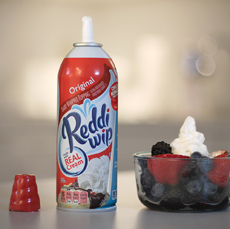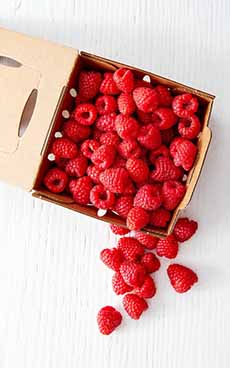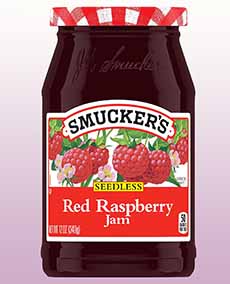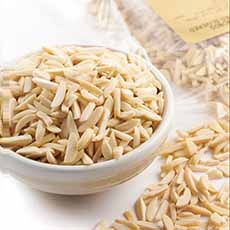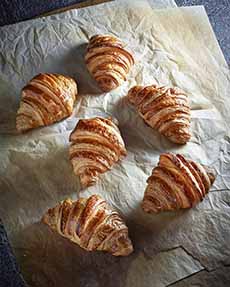RECIPE: Raspberry & Cream Croissants (Or Bagels)
 [1] For breakfast, snack or dessert, here’s how to celebrate National Raspberries & Cream Day (photo © TruWip).
|
August 7th is National Raspberries and Cream Day, and you can start the day with raspberries and cream…or end it with raspberry ice cream, made by mixing fres or frozen raspberries into vanilla ice cream. While a bowl of fresh raspberries and cream is always a delight, we typically make these Raspberries and Cream Croissants (recipe below) for breakfast. This morning, hungry for breakfast, we defaulted to a hack: Reddi-Wip. In fact, we had a can of Original Reddi-Wip and a can of Chocolate Reddi-Wip. We had two croissants; both were delish. And we admit to adding some chocolate chips with both. The winner, however, was rich, sumptuous mascarpone with raspberries—kind of like raspberry cheesecake. Look ahead: regular National Croissant Day is January 30th. > The year’s 7 raspberry holidays are below. > The year’s 80 fruit holidays. > The history of raspberries. > The history of raspberries is below. > Also below, 25 more raspberry recipes—sweet, savory, and beverages. If you prefer, substitute bagels and switch the whipped cream for whipped cream cheese. Ingredients 1. MIX the whipped cream and almond extract in a large mixing bowl. Gently fold in the raspberry jam until slightly marbled. 2. SLICE the croissants horizontally and generously spread with the cream. Top with the fresh raspberries and a scattering of slivered almonds and optional chips. TIP: If the raspberries are too plump such that you can’t easily eat the croissant, first cut them in half. We adapted this recipe from TruWhip, a dairy-free whipped topping. Try these variations: Fold the puréed raspberries into the whipped cream, skip the jam, or use another fruit jam. It is believed that red raspberries originated in Turkey and spread throughout Mediterranean Europe. Records of raspberry domestication are found in the 4th-century writings of Palladius, a Roman agriculturist, and seeds have been discovered at Roman forts in Britain (Romans planted Mediterranean fruits throughout their Empire). In Medieval Europe, wild berries were considered both medicinal and utilitarian. Their juices were used in paintings and illuminated manuscripts. At first, raspberries were a food of the rich. King Edward I (1272 – 1307) called for the broader cultivation of berries. By the 17th century, British gardens “were rich with berries and berry bushes” [source]. By the 18th century, berry cultivation practices had spread throughout Europe. Over time, superior strains were bred into the plants that we know today. Explorers and settlers in North America found Native Americans eating a wild black raspberry: firmer, but not as sweet as the red raspberry of Europe, and with more seeds. They planted the red raspberry seeds they brought from Europe. Raspberry’s name may derive from the Middle English raspise, a sweet rose-colored wine, or from raspoie, meaning “thicket,” of Germanic origin. Or, it may come from the old English rasp (a coarse file), referring to the berry’s rough surface [source]. Sweet Raspberry Recipes *You can use plain or sweetened yogurt, cottage cheese, or whipped cream cheese, for example. †This includes cheesecake! |
|
|
CHECK OUT WHAT’S HAPPENING ON OUR HOME PAGE, THENIBBLE.COM. |
||
